Discover 12 hidden attractions, cool sights, and unusual things to do in Namibia. Don't miss out on these must-see attractions: Independence Memorial Museum (Windhoek), Alte Feste (Windhoek) or Parliament Gardens (Windhoek).
Below, you can find the list of the most amazing places you should visit in Namibia.
Table of Contents
Independence Memorial Museum, Windhoek
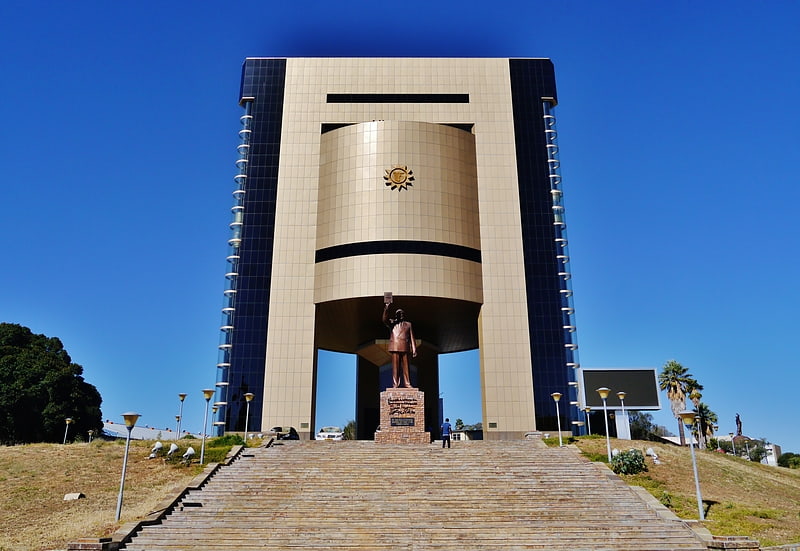
Museum in Windhoek, Namibia. The Independence Memorial Museum is a historical museum in Windhoek, the capital of Namibia. It focuses on the anti-colonial resistance and the national liberation movement of Namibia. The museum is located on Robert Mugabe Avenue and was designed and built by Mansudae Overseas Projects, a North Korean firm. The museum was inaugurated on March 21, 2014, the twenty-fourth anniversary of independence of the country, by President Hifikepunye Pohamba. It is flanked by two statues: the Sam Nujoma Statue and the Genocide Statue, also built by Mansudae. The Sam Nujoma Statue sits on the site of the German-era Reiterdenkmal equestrian statue.[1]
Address: Robert Mugabe Avenue, Windhoek
Alte Feste, Windhoek
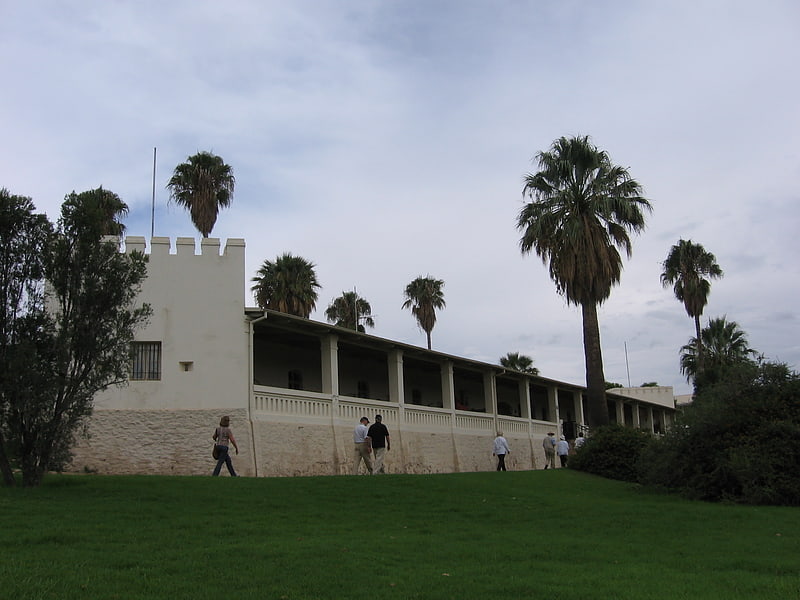
Museum in Windhoek, Namibia. The Alte Feste is a fortress and museum in downtown Windhoek, the capital of Namibia.
The building was designed by captain Curt von François to serve as headquarters of the imperial German Schutztruppe (colonial military force) during German colonization of South West Africa. The location of Windhoek, which was deserted and completely destroyed at that time, was chosen because the Germans felt it would serve as a buffer zone between the Nama and Herero tribes. The fort was, however, never involved in any military action.
The foundation was laid on 18 October 1890 by then Schutztruppe private Gustav Tünschel. The building was redesigned multiple times during the first years; its final layout was only completed in 1915. It consists of an inner courtyard with high walls and accommodation for the troops on the inside, as well as four towers. Alte Feste is the oldest surviving building in the city which subsequently developed around it.
After the World War I German surrender in South West Africa Windhoek was occupied by the South African Army in March 1915. Alte Feste now served as military headquarters for the South African Union troops.
In 1935 the fort was used for a more peaceful purpose when it was converted into a hostel for the adjacent Windhoek High School. Already severely dilapidated, it was declared a National Monument in 1957. The building was renovated extensively in 1963, and since then accommodates the National Museum of Namibia.
In 2010, the Reiterdenkmal, Windhoek's well-known equestrian monument, was placed in front of Alte Feste. It was removed and placed in storage on Christmas Day in 2013.[2]
Parliament Gardens, Windhoek
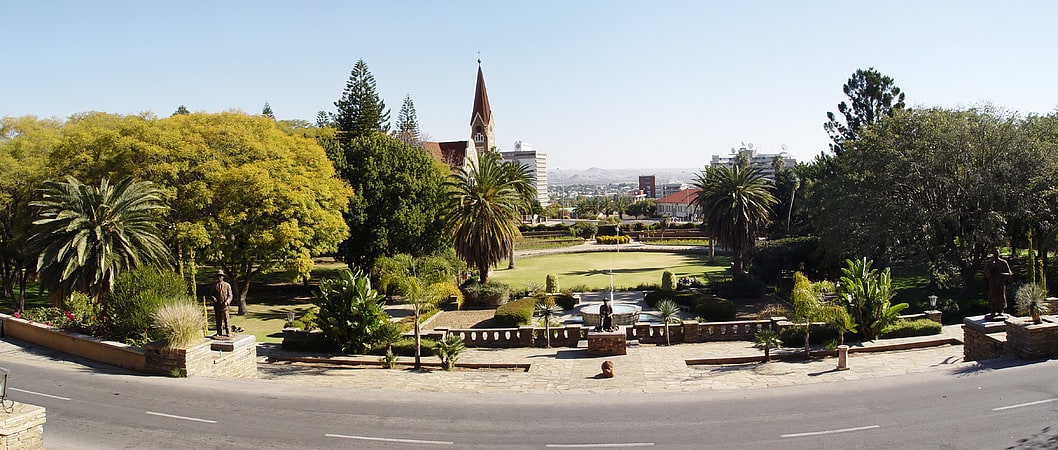
Park in Windhoek, Namibia. Parliament Gardens is a small park in downtown Windhoek, Namibia. It is located between the Tintenpalast and the Christuskirche. It was laid out in 1932 and was originally called the Tintenpalast gardens, adopting its present name after Namibian independence in 1990.
Parliament Gardens contains Namibia's first post-independence monument: a bronze-cast statue of the Herero chief Hosea Kutako. Two other Namibian nationalists are also honoured with bronze statues in the gardens: Hendrik Samuel Witbooi and Theophilus Hamutumbangela. The three statues flank the steps up to parliament's main entrance.
The gardens used to be an olive plantation, and still include an olive grove. They also contain a bowling green lined with bougainvilleas along with a thatched-roof clubhouse. Twice a month the gardens host "Theatre in the Park", run by the College of the Arts.
In 2016, the opening of the Namibian Parliament was held in the Parliament Gardens because of limited space in the Tintenpalast. Due to a change to the Constitution in 2014, the number of parliamentarians had increased significantly, and so joint sittings have to be held elsewhere.
Rough Guides describes Parliament Gardens as "delightful, shady.. definitely merit a stroll". The gardens are "particularly popular at lunchtimes and weekends, when students laze on the lawns poring over their books or each other." They are also a "popular place for a lunchtime picnic."[3]
Martin Luther Steam Locomotive, Swakopmund
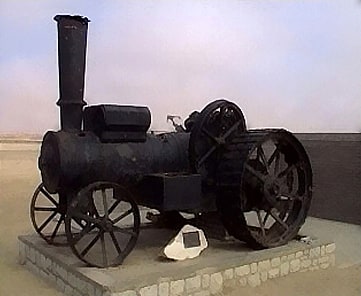
Martin Luther is an 8 NHP Compound J & H McLaren steam-driven traction engine Works No 527 built in November 1895 in Leeds, West Yorkshire, UK and abandoned in the desert of Skeleton Coast outside of the town of Swakopmund in Namibia, ca. 4 km from the town centre.
The "Road Locomotive" was brought to German South-West Africa by First Lieutenant Edmund Troost of the Schutztruppe for use for freight service between Swakopmund and the interior of the country, for which ox wagons had been used. The route had insufficient grazing for the oxen because of droughts and seasonal conditions, and a great many oxen died along the way.
To remedy this situation, Troost purchased the traction engine through the J & H McLaren Engineers (Leeds) agents in Germany, Fr. Dehne in Halberstadt, and had it shipped from Hamburg to Swakopmund. However, at its destination it was found that the offloading facilities could not cope with the locomotive's weight of 280 cwt (ca. 14 tonnes), and the ship continued to Walvis Bay, where the locomotive could be offloaded.
The locomotive then remained in Walvis Bay for the next four months, as Troost had other obligations in Cape Town. When Troost was able to attend to the matter again, the engine driver hired to drive it had already left for Europe again. The engine was then driven by an American and a Boer to Swakopmund over the next three months, with the engine sinking in sand almost every 50 metres. Enormous quantities of water were also required for the operation of the locomotive.
In Swakopmund, only inadequate service was available, and very few spare parts. However, the engine transported a few loads to Nonidas (ca. 11 km) and to Heigamchab.
At the beginning of 1897, due to incorrect handling, the engine ground to a halt about 4 km outside of Swakopmund, and was abandoned there. A local resident Max Rhode is said to have said in a gathering in the Bismarck Hotel the following words: “Did you know that the steam ox is called ‘Martin Luther’ now because it can also say — ‘Here I stand, I can do no other’”. Thus the engine gained its present name, although recent scholars have doubts as to whether Luther ever did utter these words.
The engine has been restored twice, first in 1973, and more recently between 2000 and 2004. After the second restoration job, a protective house was built for the engine, as it was by then apparent that the frequent mists of Swakopmund would quickly damage the engine again.[4]
Address: Hwy B2, Swakopmund
National Marine Aquarium of Namibia, Swakopmund
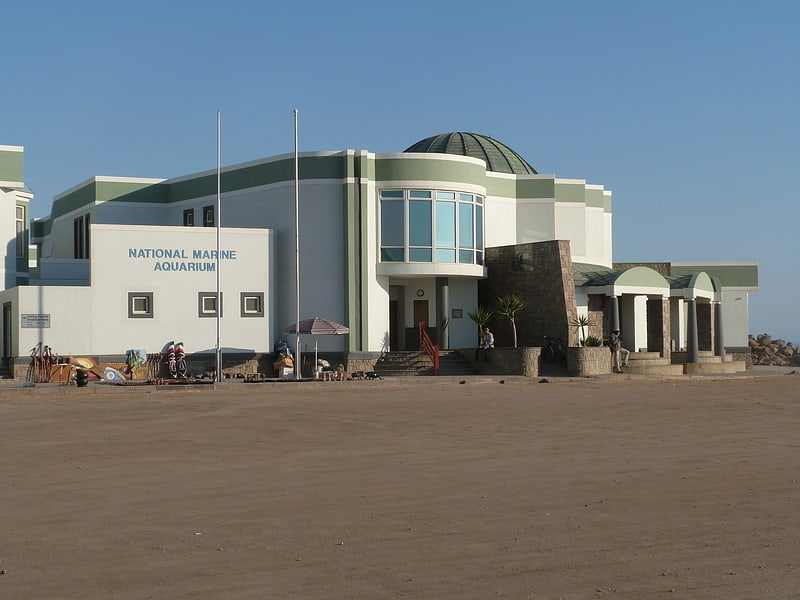
Snug aquarium with local marine life. The National Marine Aquarium of Namibia is an aquarium in Swakopmund, Namibia. The Aquarium features fauna from the cold Benguela Current in the southern Atlantic Ocean.[5]
Address: Strand Street, Swakopmund
Pelican Point Lighthouse, Walvis Bay

The Pelican Point Lighthouse is a lighthouse overlooking the Atlantic Ocean from Pelican Point, a long sandbar guarding Walvis Bay, Namibia. It was opened by the South African government in 1932. The round, cast-iron, 34-meter-high tower features a lantern and gallery and is painted in horizontal black and white bands.[6]
Kristall Galerie, Swakopmund
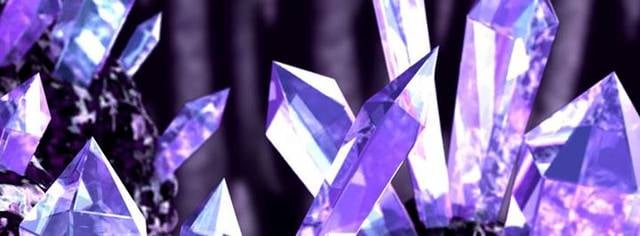
Gift shop, Shopping, Museum
Address: Corner of Tobias Hainyeko and Theo-Ben Gurirab Avenue, Swakopmund
St. Matthew's Anglican Church, Walvis Bay
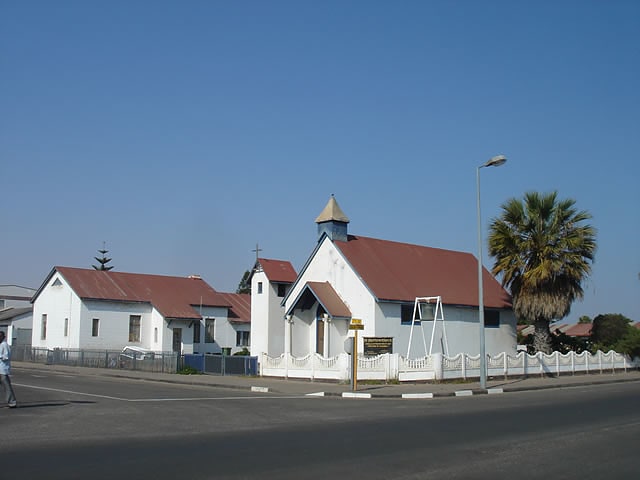
St. Matthew's Anglican Church is an Anglican church in Walvis Bay, Namibia. It is part of the Anglican Diocese of Namibia, which is a diocese of the Anglican Church of Southern Africa.
The church was consecrated on 21 September 1924 by Bishop Nelson Fogarty. It was originally built with wood and placed on stilts but was later covered in chicken mesh and plaster coating. The bell of St. Matthew's dates to 1623. Weighing 600kg, it is now cracked and no longer rings.
St. Matthew's is the second oldest still-standing structure in the city. By 2008, it was crumbling and had a dwindling congregation. Despite being the second oldest structure in Namibia's second largest city, it was not registered as an historical monument as of September 2008.
The church is one of three in the parish of Walvis Bay; the other two are St. Saviour's and Holy Redeemer.[7]
Rheinische Missionskirche, Walvis Bay
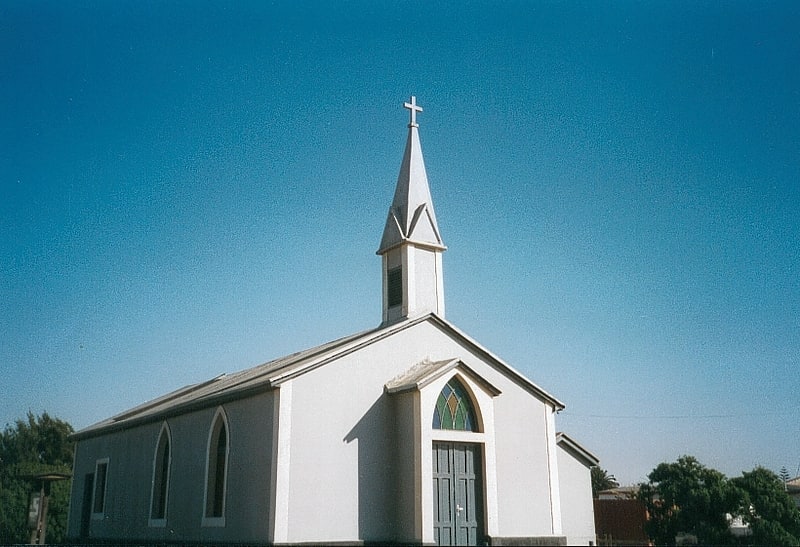
Church
Dune 45, Namib-Naukluft National Park
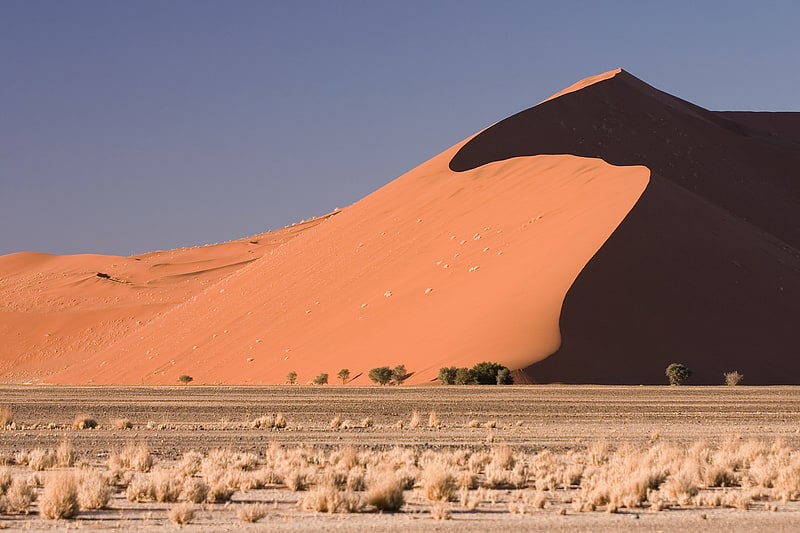
Dune 45 is a star dune in the Sossusvlei area of the Namib Desert in Namibia. Its name comes from the fact that it is at the 45th kilometre of the road that connects the Sesriem gate and Sossusvlei. Standing over 170 m, it is composed of 5-million-year-old sand that is detritus accumulated by the Orange River from the Kalahari Desert and then blown here..
Because it is near the road the dune is often photographed, particularly early and late in the day when one side of the dune is in shadow. It is often climbed by visitors to Sossusvlei.[8]
Naukluft Mountains, Namib-Naukluft National Park
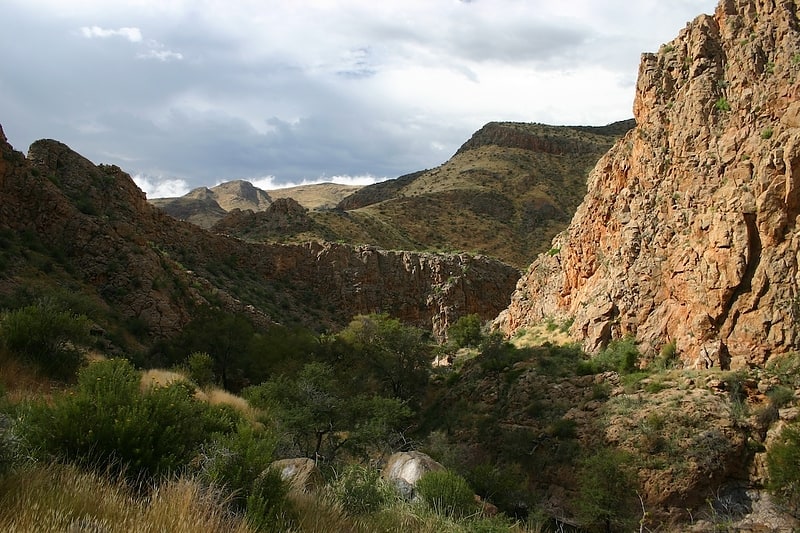
Mountain range in Namibia. The Naukluft Mountains are a mountain range in central Namibia. The southern part of the mountain range forms the easternmost part of the Namib-Naukluft National Park. The northern mountains are occupied by privately held farms. They are known for their wildlife, including mountain zebras and leopards. The mountains have many small streams and waterfalls.
Naukluft is the Namibian German rendering of the Afrikaans Noukloof, meaning "narrow ravine", from nou ('narrow', cf Dutch nauw) and kloof ('ravine', cf German Kluft).[9]
Tropic of Capricorn, Namib-Naukluft National Park
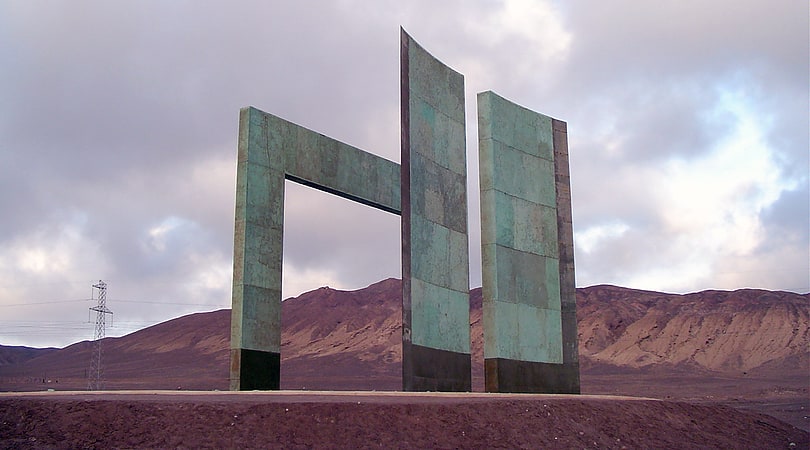
The Tropic of Capricorn is the circle of latitude that contains the subsolar point at the December solstice. It is thus the southernmost latitude where the Sun can be seen directly overhead. It also reaches 90 degrees below the horizon at solar midnight on the June Solstice. Its northern equivalent is the Tropic of Cancer.
The Tropic of Capricorn is one of the five major circles of latitude marked on maps of Earth. Its latitude is currently 23°26′11.0″ south of the Equator, but it is very gradually moving northward, currently at the rate of 0.47 arcseconds, or 15 metres, per year.
Less than 3% of the world's population lives south of it; this is equivalent to about 30% of the population of the Southern Hemisphere.[10]